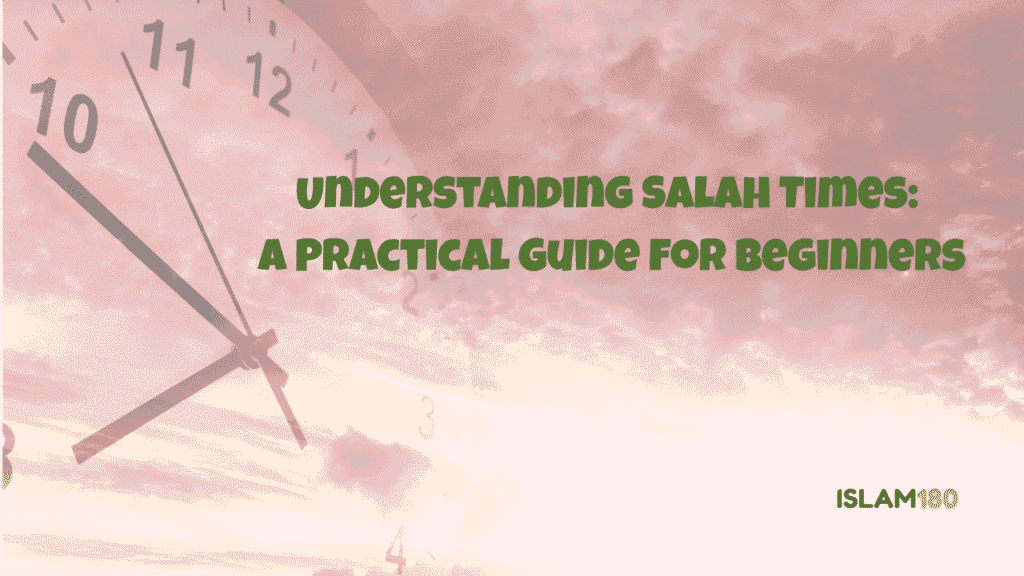Introduction of Salah times for beginners
Prayer (Salah) is the second pillar of Islam and an essential act of worship for every Muslim. While learning how to perform Salah is crucial, knowing when to pray is equally important. Many Muslims, especially beginners, often feel confused about the exact timing for each prayer. This comprehensive guide will walk you through everything you need to know about Salah times for beginners in a simple and practical way.
Whether you’re a new Muslim, someone rediscovering their faith, or a parent teaching your children, understanding Salah times is the first step toward a disciplined spiritual life.
Importance of Observing Prayer Times
Allah says in the Quran:

“Indeed, prayer has been decreed upon the believers a decree of specified times.” (Surah An-Nisa, 4:103)
This verse highlights that timeliness in Salah is not optional but a divine command. The Prophet Muhammad (peace be upon him) also emphasized praying at the earliest time as the most beloved act to Allah.
Each of the five daily prayers has a specific window of time, and missing that window without a valid excuse can make the prayer invalid.
The Five Daily Prayers and Their Time Windows
Let’s explore each Salah, its meaning, and its correct timing:
1. Fajr (Dawn Prayer)
- Time Starts: At the true dawn (when a faint white line appears on the horizon)
- Time Ends: Just before sunrise
- Tips: You can easily identify it with prayer apps or Islamic calendars. It’s recommended to pray as early as possible.
2. Dhuhr (Noon Prayer)
- Time Starts: When the sun has passed its zenith (highest point)
- Time Ends: Before the shadow of an object becomes twice its length (or just before Asr)
- Tips: Dhuhr is typically prayed during work or school breaks. Try scheduling reminders.
3. Asr (Afternoon Prayer)
- Time Starts: When the shadow of an object is equal to its length (according to the Hanafi school, twice its length)
- Time Ends: Just before sunset
- Tips: This prayer can be tricky; use reliable apps or a local Islamic center’s timetable.
4. Maghrib (Sunset Prayer)
- Time Starts: Immediately after sunset
- Time Ends: When the red twilight disappears
- Tips: Maghrib time is short, so it’s important to pray soon after the Adhan.
5. Isha (Night Prayer)
- Time Starts: When the red twilight disappears
- Time Ends: Until midnight (or just before Fajr begins)
- Tips: Try not to delay Isha unnecessarily; early prayers bring more barakah.
How to Determine Salah Times in Practice
Today, we’re blessed with numerous tools that make it easy to keep track of Salah times. Here are practical ways to know your prayer times accurately:
1. Islamic Prayer Apps
- Apps like Muslim Pro, Athan, or IslamicFinder offer accurate timings based on your location.
- Most apps allow Adhan notifications and Qiblah direction.
2. Masjid Timetables
- Local mosques often publish monthly Salah calendars.
- Printed or digital versions are available from your community masjid.
3. Online Websites
- Websites like IslamicFinder.org or PrayerTimes.org allow you to enter your city and get daily timings.
4. Manual Observation (Traditional Method)
- You can observe the sky’s changes throughout the day.
- Learning basic astronomy used by early Muslims can be spiritually enriching.
Common Mistakes and Misconceptions
Even sincere Muslims sometimes make errors in observing prayer times. Here are some common ones and how to avoid them:
- Praying before the time starts: Always verify with a calendar or app.
- Delaying prayers without reason: Try to pray at the start of the time for maximum reward.
- Relying on incorrect sources: Avoid random Google searches. Use reliable Islamic sources.
- Confusing Asr time (Hanafi vs. other schools): Know your school of thought or follow your local mosque.
- Time changes due to daylight savings: Update your apps and calendars.
Helpful Resources and Tools
Here are some recommended tools to keep you on track:
- Apps: Muslim Pro, Athan, IslamicFinder
- Websites: IslamicFinder.org, Alhabib.info
- Printables: Consider downloading our free Salah Time Chart (available soon)
- Masjid Calendar: Ask your local mosque for a timetable
Frequently Asked Questions (FAQs)
Q1: What if I miss a prayer?
Perform it as soon as you remember. It’s called Qada Salah. However, habitual negligence is a serious matter.
Q2: Can I combine prayers?
Yes, under certain conditions such as travel or illness, Dhuhr + Asr and Maghrib + Isha can be combined.
Q3: Do Salah times change daily?
Yes, due to the sun’s movement, prayer times shift slightly each day.
Q4: Can I pray with a time delay if I’m at work or school?
Try to pray within the valid time. Use breaks or ask for prayer accommodation.
Conclusion
Knowing Salah times is not just about technical accuracy; it reflects your dedication to obeying Allah in every moment. With today’s tools, it’s easier than ever to maintain punctuality in your prayers.
Let your daily schedule revolve around Salah, not the other way around. Make Salah the anchor of your day, and you’ll find barakah (blessing) in everything you do.
Stay Connected!
Enjoyed this post? Subscribe to islam180.com and never miss an update!
We’re preparing our next guide: “How to Perform Salah: A Step-by-Step Illustrated Guide with Proofs.” Be the first to read it by signing up for our newsletter.
BarakAllahu feekum! May Allah keep us steadfast in our prayers.


